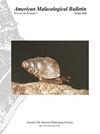弱厄尔尼诺Niño 2006-07和进一步过渡到La Niña期间西下加利福尼亚州的全浮游软体动物
IF 0.4
4区 生物学
Q4 MARINE & FRESHWATER BIOLOGY
引用次数: 1
摘要
摘要:尽管加利福尼亚海流中上层软体动物具有重要的生态意义和对气候变化的脆弱性(如海洋酸化和缺氧),但对它们的研究很少。我们分析了三年间(2006-2008年)沿平行于下加利福尼亚海岸的横切线的全浮游软体动物的丰度。物理因素的主要差异表现为温度和盐度自北向南升高,尤金尼亚峰以南(28°N)溶解氧浓度较低。氧浓度最低出现在夏季,部分地区100m以上缺氧(< 0.5 ml·L-1)。浮游软体动物的丰度在纬度梯度上没有差异,除了Desmopterus pacificus Essenberg(1919)和Pterotrachea Forskal属个体(1775)。相反,时间变率高,主要在季节尺度上,但也在年尺度上。El Niño 2006-2007和La Niña 2007 - 2008的影响是明显的,在El Niño-La Niña过渡期间,2007年4月Corolla spectabilis Dall, 1871的急剧增加。2008年,尽管叶绿素浓度较高(高达3.26 mg·m-3),但远洋软体动物在冬春季仍保持中等丰度。随后,在2008年7月La Niña的第一脉冲放松期间,异足类Atlanta Lesueur, 1817的丰度出现反弹。以及裸子目的个体。氧梯度对大多数属(Clio Linnaeus, 1767年,Limacina Bosc, 1817年,Atlanta和Firoloida Lesueur, 1817年)和Gymnosomata目软体动物丰度的影响呈负相关,但对Cavolinia Abildgaard, 1791年,Creseis Rang, 1828年,Desmopterus和Pterotrachea,盐度梯度的影响更大。因此,全浮游软体动物属是气候变化的有用指标。本文章由计算机程序翻译,如有差异,请以英文原文为准。
Holoplanktonic Mollusks off Western Baja California During the Weak El Niño 2006-07 and Further Transition to La Niña
Abstract:
There are few studies on pelagic mollusks from the California Current, despite their ecological importance and vulnerability to climate change (e.g., ocean acidification and hypoxia). We analyzed abundances of holoplanktonic mollusks during three years (2006–2008) along a transect-line parallel to the Baja California coast. The main differences in physical factors were increasing temperature and salinity from north to south, and lower dissolved oxygen concentration south of Punta Eugenia (28°N). The lowest oxygen concentrations occurred in summer, with hypoxic conditions (< 0.5 ml · L-1) in the upper 100 m depth at some locations. Planktonic mollusk abundance did not differ along the latitudinal gradient, excepting Desmopterus pacificus Essenberg, 1919 and individuals from the genus Pterotrachea Forskal, 1775. In contrast, the temporal variability was high, mainly in a seasonal scale but also among years. The influence of El Niño 2006–2007 and La Niña 2007–2008 were evident by a sharp increase of Corolla spectabilis Dall, 1871 in April 2007 during the El Niño-La Niña transition. During 2008, pelagic mollusks remained with moderate abundance in winter-spring despite the high chlorophyll concentrations recorded (up to 3.26 mg · m-3). Subsequently, during the relaxation of a first pulse of La Niña in July 2008, there was a rebound in the abundance of the heteropod Atlanta Lesueur, 1817. and individuals in the Order Gymnosomata. The oxygen gradient inversely influenced mollusk abundance in most of the genera (Clio Linnaeus, 1767, Limacina Bosc, 1817, Atlanta, and Firoloida Lesueur, 1817) and the order Gymnosomata, but for Cavolinia Abildgaard, 1791, Creseis Rang, 1828, Desmopterus, and Pterotrachea, the salinity gradient was more influential. Therefore, holoplanktonic mollusks genera were useful indicators of climatic variability.
求助全文
通过发布文献求助,成功后即可免费获取论文全文。
去求助
来源期刊
CiteScore
1.00
自引率
40.00%
发文量
1
审稿时长
>12 weeks
期刊介绍:
The American Malacological Bulletin serves as an outlet for reporting notable contributions in malacological research. Manuscripts concerning any aspect of original, unpublished research,important short reports, and detailed reviews dealing with molluscs will be considered for publication. Recent issues have included AMS symposia, independent papers, research notes,and book reviews. All published research articles in this journal have undergone rigorous peer review, based on initial editor screening and anonymous reviewing by independent expertreferees. AMS symposium papers have undergone peer review by symposium organizer, symposium participants, and independent referees.

 求助内容:
求助内容: 应助结果提醒方式:
应助结果提醒方式:


